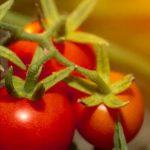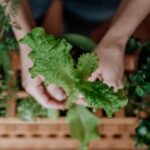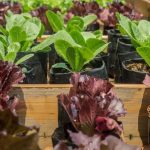Are you interested in growing your own vegetables but lack the space for a traditional garden? Outdoor container vegetable gardening might be the perfect solution for you. In this article, we will explore the benefits of this approach and provide valuable insights into choosing the best soil mix for successful container gardening. Whether you’re a novice gardener or an experienced one looking to expand your produce, finding the right soil mix is crucial for healthy and abundant vegetable yields.
Container vegetable gardening offers several advantages, particularly for individuals with limited outdoor space. It allows you to grow a variety of vegetables on your patio, balcony, or any small outdoor area. With the right soil mix and containers, you can enjoy fresh produce without the need for a large plot of land. Additionally, container gardening provides more control over soil quality and conditions, making it easier to prevent pests and diseases from affecting your plants.
To achieve success with outdoor container vegetable gardening, it’s essential to understand the significance of using high-quality soil mix. The right blend will provide adequate nutrients, moisture retention, and proper drainage for your plants to thrive in a confined environment.
In the following sections, we will delve deeper into how to choose suitable containers and discuss the key components of the best soil mix for outdoor container vegetable gardening. Whether you’re growing tomatoes, peppers, lettuce, or herbs in containers, having the right soil mix is fundamental to achieving optimal results.
Choosing the Right Containers for Vegetable Gardening
When it comes to outdoor container vegetable gardening, choosing the right containers is crucial for the success of your plants. The type of container you select can impact factors such as moisture retention, drainage, and overall plant health. Here are some key considerations to keep in mind when choosing containers for your vegetable garden:
1. Size: Select containers that are large enough to accommodate the root systems of your chosen vegetables. Some vegetables, such as tomatoes and peppers, require deeper containers for proper root development.
2. Material: Consider the material of the containers, such as plastic, ceramic, or wood. Each material has its own advantages and disadvantages in terms of durability, insulation, and water retention.
3. Drainage: Ensure that the containers have adequate drainage holes to prevent waterlogging, which can lead to root rot and other diseases.
4. Mobility: If you plan on moving your containers around to optimize sunlight exposure or for aesthetic reasons, consider selecting lightweight containers or ones with built-in wheels.
5. Compatibility with Soil Mix: Keep in mind the type of soil mix you will be using (such as a well-draining blend suitable for vegetables) and make sure that it is compatible with the containers you choose.
By carefully considering these factors, you can select the most suitable containers for your outdoor container vegetable garden and set yourself up for success with the best soil mix for outdoor container vegetable gardening.
Understanding the Importance of a Good Soil Mix for Container Gardening
When it comes to outdoor container vegetable gardening, the soil mix you choose can make all the difference in the success of your plants. The right soil mix provides essential nutrients, proper drainage, and aeration for healthy root development. It acts as a reservoir for water and nutrients, which is crucial since container gardens tend to dry out faster than traditional gardens. Therefore, understanding the importance of a good soil mix is key to achieving thriving vegetable plants in containers.
Key Components of the Best Soil Mix for Outdoor Container Vegetable Gardening
The best soil mix for outdoor container vegetable gardening should include a balance of components that provide the necessary support and nutrition for your plants. Here are some key components to consider including in your soil mix:
- High-quality potting soil: Choose a well-draining potting soil with a loamy texture that holds moisture but doesn’t become waterlogged.
- Organic matter: Adding compost or well-rotted manure helps improve soil structure, fertility, and moisture retention.
- Perlite or vermiculite: These materials improve aeration and drainage in the soil mix.
- Sand: A small amount of sand can be added to improve drainage in heavy soils.
- Balanced fertilizer: Incorporating a balanced organic fertilizer ensures your plants receive essential nutrients throughout their growth.
Tips for Mixing Your Own Soil Blend
If you prefer to mix your own soil blend for outdoor container vegetable gardening, follow these tips:
- Use equal parts potting soil, compost, and perlite or vermiculite.
- Add sand if needed based on your specific plant’s requirements.
- Mix in an organic slow-release fertilizer according to package instructions.
By understanding the importance of these components and following these tips, you can create the best soil mix for outdoor container vegetable gardening that will support healthy plant growth throughout the growing season.
Key Components of the Best Soil Mix for Outdoor Container Vegetable Gardening
When it comes to outdoor container vegetable gardening, the key to success lies in the soil mix. The right combination of soil components can make all the difference in the health and productivity of your vegetable plants. Here are the key components of the best soil mix for outdoor container vegetable gardening:
Organic Matter
One of the most important components of a good soil mix for container vegetable gardening is organic matter. This could include compost, well-rotted manure, or other types of organic materials that add nutrients to the soil and improve its structure. Organic matter also helps with water retention and provides a habitat for beneficial microorganisms.
Perlite or Vermiculite
In order to promote proper drainage and aeration in your container garden, adding perlite or vermiculite to your soil mix is essential. These lightweight materials help prevent compaction and allow roots to breathe, ultimately leading to healthier and more productive plants.
Quality Potting Soil
A high-quality potting soil serves as the base for your soil mix and should be well-draining while still retaining moisture. Look for potting soils specifically formulated for vegetables or create your own blend using peat moss, coconut coir, or other sustainable materials.
By incorporating these key components into your soil mix, you can create an ideal environment for healthy and thriving vegetables in your outdoor container garden. Whether you are growing tomatoes, peppers, lettuce, or herbs, getting the right soil mix will set the foundation for a successful harvest.
Tips for Mixing Your Own Soil Blend
When it comes to outdoor container vegetable gardening, the soil mix you use can make a significant impact on the success of your garden. While there are pre-mixed soil blends available for purchase, many seasoned gardeners prefer to create their own custom mix.
This allows for greater control over the composition and ensures that the unique needs of their vegetable varieties are met. If you’re considering mixing your own soil blend for your container garden, here are some tips to help you get started.
Understanding Your Vegetable’s Needs
Before you begin mixing your own soil blend, it’s essential to understand the specific needs of the vegetables you plan to grow. Different plants have different requirements when it comes to soil pH, drainage, and nutrient levels. Research the ideal growing conditions for each variety and tailor your soil mix accordingly.
Key Components for a Custom Soil Blend
A basic custom soil blend for outdoor container vegetable gardening typically consists of three main components: peat moss or coconut coir (for moisture retention), perlite or vermiculite (for aeration and drainage), and compost (for nutrients). The proportions of each component will vary depending on the specific needs of your plants, but a general rule of thumb is one part peat moss or coir, one part perlite or vermiculite, and one part compost.
Mixing and Testing Your Blend
Once you have gathered all the necessary components for your custom soil blend, thoroughly mix them together in a large container or wheelbarrow. Take care to ensure that all ingredients are evenly distributed throughout the mixture.
Before filling your containers with the soil blend, perform a simple test by squeezing a handful of the mix in your hand. If it holds together without dripping excess water and breaks apart easily when touched, then it’s ready to use in your outdoor container vegetable garden.
Best Practices for Preparing Containers and Filling With Soil
Choosing the right containers and preparing them with the best soil mix are essential steps for successful outdoor container vegetable gardening. To start, it’s important to select containers that are suitable for growing vegetables. Look for containers that are at least 12 inches deep and have sufficient drainage holes to prevent waterlogging.
Once you have chosen the appropriate containers, it’s time to prepare them for gardening. Before filling them with soil, make sure to clean the containers thoroughly to remove any debris or disease-causing pathogens that may be present. This step is crucial in promoting a healthy growing environment for your vegetables.
After cleaning the containers, it’s time to fill them with the best soil mix for outdoor container vegetable gardening. The ideal soil mix should be well-draining and moisture-retentive, providing a balance of aeration and water-holding capacity for optimal plant growth. A great soil mix for vegetable container gardening typically consists of a combination of high-quality potting soil, compost, perlite or vermiculite, and organic matter such as coconut coir or peat moss.
By following these best practices for preparing containers and filling them with a nutrient-rich soil mix, you will create an ideal growing environment for your outdoor container vegetable garden. These initial steps are essential in ensuring the success of your vegetable plants and maximizing their yield.
Maintenance Tips for Keeping Soil Mix Healthy and Nutrient-Rich
Maintaining a healthy and nutrient-rich soil mix is essential for the success of outdoor container vegetable gardening. In order to ensure that your plants thrive, it’s important to pay attention to the ongoing care of the soil in your containers. By following some key maintenance tips, you can promote healthy growth and bountiful harvests.
One crucial aspect of maintaining soil health is regular watering. Container gardens often require more frequent watering than traditional garden beds, as the soil in containers tends to dry out more quickly.
It’s important to monitor the moisture level of the soil and provide water as needed to keep it consistently moist, but not waterlogged. Additionally, using a self-watering container or adding a layer of mulch on top of the soil can help retain moisture and reduce the frequency of watering.
In addition to proper watering, it’s important to replenish nutrients in the soil over time. Regular fertilization is key to ensuring that your vegetables have access to all the essential nutrients they need for healthy growth. Consider using a slow-release organic fertilizer or a liquid fertilizer diluted according to label instructions. This will help maintain a balanced nutrient profile in your soil throughout the growing season.
| Maintenance Tips | Benefits |
|---|---|
| Regular watering | Prevents dehydration and promotes healthy plant growth. |
| Replenishing nutrients | Ensures that plants have access to vital nutrients for optimal development. |
Best Vegetable Varieties for Container Gardening and Soil Mix Considerations
When it comes to outdoor container vegetable gardening, choosing the best vegetable varieties is crucial for a successful harvest. Not all vegetables thrive in container gardens, so it’s important to select varieties that are well-suited for this type of environment. Some of the best vegetable varieties for container gardening include tomatoes, peppers, lettuce, spinach, carrots, radishes, and green onions. These vegetables can be grown successfully in containers and can thrive with the right soil mix.
In addition to choosing the right vegetable varieties for container gardening, it is essential to consider soil mix considerations. The best soil mix for outdoor container vegetable gardening should be well-draining, lightweight, and nutrient-rich. A good soil mix will provide the necessary support and nutrients for the vegetables to grow healthy and produce abundant crops.
When preparing the soil mix for container gardening, it’s important to consider key components such as peat moss or coconut coir for moisture retention, perlite or vermiculite for aeration, and compost or organic matter for nutrient content. These components work together to create an ideal environment for vegetable growth in containers.
It’s important to note that not all soil mixes are suitable for outdoor container vegetable gardening. Certain types of soils may lead to poor drainage or compacting issues which can negatively impact plant growth. By using the right soil mix and selecting the best vegetable varieties suited for containers, you can create a thriving outdoor container garden and enjoy an abundant harvest of fresh vegetables.
| Vegetable Varieties | Soil Mix Considerations |
|---|---|
| Tomatoes | Well-draining and nutrient-rich |
| Peppers | Lightweight with good moisture retention |
| Lettuce | Aeration with nutrient content |
Conclusion
In conclusion, achieving success with outdoor container vegetable gardening heavily relies on using the best soil mix. A well-balanced soil mix is essential for ensuring that your vegetable plants receive the necessary nutrients, moisture, and aeration for healthy growth and abundant harvests. By understanding the key components of the best soil mix for outdoor container vegetable gardening and following the tips for mixing your own blend, you can create an ideal growing environment for your plants.
Furthermore, taking into consideration the maintenance tips for keeping the soil mix healthy and nutrient-rich is crucial for long-term success. Regularly replenishing nutrients through organic fertilizers and compost, as well as proper watering practices, will help ensure that your plants thrive throughout the growing season. Additionally, selecting the best vegetable varieties for container gardening and considering soil mix requirements specific to each type of plant is important for maximizing yields.
Ultimately, with the right containers, proper preparation techniques, and diligent maintenance practices in place, you can create a thriving garden using the best soil mix for outdoor container vegetable gardening. Whether you are a beginner or experienced gardener, investing in high-quality soil mix will provide a solid foundation for growing a wide range of vegetables in containers, allowing you to enjoy fresh produce right from your own backyard.

If you’re looking to get into vegetable gardening, or are just looking for some tips on how to make your current garden better, then you’ve come to the right place! My name is Ethel and I have been gardening for years. In this blog, I’m going to share with you some of my best tips on how to create a successful vegetable garden.





